Author: admin
us-and-the-nicaraguan-contra-affair
Us and the Nicaraguan contra affair
Costa Rica throws up some surprises every so often. This evening, we had dinner in a restaurant called ‘The Airplane’. Nothing odd about a restaurant called the airplane. Plenty odd, though, about a bar and nightclub which are housed inside a Fairchild C123 which looks to all intents and purposes like it crash landed into the side of the cliffs here.
Rather boringly, and disappointingly, it turns out that the plane made its way here in bits by boat having been purchased for $3,000 and was reassembled here on site, with restaurant being built around it and bar and night club built inside it. Actually, it almost made it here by railroad, but the fuselage was 10 inches too wide for the bridges.
Far less dull is the plane’s history. When Ronald Reagan was mired in the unsavoury contras scandal (the US in subversive deals to divert the course of politics of other nations? Surely fiction?), there was a secret airfield in. Costa Rica used to take munitions across into Nicaragua, and 4 planes were based in this airfield. One was shot down and the pilot captured in southern Nicaragua. And one was abandoned, and now houses a bar and nightclub in Manuel Antonio with a stunning beach view backing a natural reserve.
We weren’t expecting that as we ordered 4 portions of chicken fingers and chips for the kids. As luck would have it, the food was pretty outstanding too.
Leave a Reply
volunteering-at-the-children-eternal-rainforest
Volunteering at the Children’s Eternal Rainforest

T Cleans up the rainforest
We have had a near daily education as to the etymological makeup of the word ‘rainforest’, and the critical 4 letter difference from the word ‘forest’. Today was no different, but fortunately the downpour came after our work was done.
We took the children to Monteverde’s Children’s Eternal Rainforest (Bosque Eterno de los Niños). This endangered rainforest gained some fans from a school in Sweden, who after learning of the rainforest’s plight, started fundraising activities that grew to encompass children from 44 countries. With the funds raised, they are buying tracts of forest and protecting these from being cut down for wood. They are currently fundraising to extend a corridor from the forest which would allow birds to migrate South for whom the current journey is too long.
We started our volunteering activities there in the morning. Wendy, who was looking after us, told us that in the year that she’s been here, we’re the first family to volunteer. This struck me as somewhat sad, as it is a great opportunity for kids to start to understand the environment, the cycle of life and nature’s workings first hand. Our onerous task was to sweep leaves from a path through the forest and collect them for composting. The older two boys were great, the youngest two engaged in diversionary and occasionally subversive tactics. Our efforts were also punctuated by frequent trips back up the path to take one or the other of them to the toilet. Despite this, we managed over the three days to clear the entire path and collect about 18 bags for composting (This compared to a group of 20 American students a few weeks prior who managed to collect one bag over the course of a day. It astounds me sometimes how some ‘volunteers’ fail to see that volunteering is a responsibility rather than (just?) a favour).
When we took the bags to the greenhouse where the composting would take place, Wendy explained to us what the compost would be used for. Done in kids’ terms so that Paola and I would understand. It was for an interesting programme. A local artist aptly named Willow had taken it upon herself to convince the local hoteliers and restaurateurs not to import exotic plants from other parts of the world to adorn their properties, and thereby upset the delicate local balance. The alternatives she offered them were stunning locally grown plants which would more than beautify a garden or property, and would continue to keep the environment here in balance. I don’t know whether she charged for them – I would hope that they are part of the fundraising for the forests here, but it struck me as a tremendous social enterprise. Very local, very needed, and value adding.
On days 2 and 3, Wendy was unfortunately rather ill. Instead, we were accompanied by Elias, who was from one of Costa Rica’s endangered 24 indigenous communities. Unlike the Maya in Mexico, these groups, who’s origins more or less coincided with the Maya, receive no protection from the national government, and their language and culture are in serious danger of extinction as the younger members take up English as a second language after Spanish, relegating their own mother tongue to obsolescence.
As I write, Elias is studying for his masters in sustainability, and is engaged in reviewing some of the policies and implementations in the local area. It was fascinating for me to learn about the double-speak that occurs in the area of ecotourism at all levels. At a national level, a government that recognises the national treasure that is Costa Rica’s unique and rich biodiversity, and places much of its public relations around this fact. Meanwhile, licences are handed out to mining companies and oil explorers in ways that will threaten much of the environment that the government is so fond of talking about. At a business level, again many businesses, especially in the ecotourism trade, make much of their sustainability credentials while pumping polluting effluent into the local streams. At an individual level, many people who make their names on the sustainability and environmentalist speaking circuit while not actually engaging in actual work in the field. None of these double standards are unique to the fields of environmentalism and sustainability, but it was fascinating seeing this first hand.
(Aside – random idea. Create an ecotourism sustainability index that would be monitored by an independent organisation. This would award a score to ecotourism (and other) businesses on the basis of a variety of criteria relevant for their business. The scores would be made visible to the various tourist and ecotourist organisations such as Lonely Planet or TripAdvisor, who would also fund the independent awarding body. This would encourage hotels and other businesses to put their actions where their PR is, as people engaging in ecotourism would start to avoid bad-scoring hotels and businesses. End of aside.)
It was also fascinating to learn of the unique relationship between some of Costa Rica’s environmental movements and the Quakers. A number of Quakers had moved to Costa Rica back in 1950 after serving time for refusing to do military service in the USA. You could see the appeal from that perspective of moving to a country that at the same time was actually abolishing its entire military forces (yup, Costa Rica has no army, air force or navy). However, the Quakers’ philosophical view of the preservation of nature as well as a long-term vision that saw the importance of protecting the rainforest to protect their water supply helped the local environmental efforts no end.
Now with the Quakers ageing and not being replaced, a government that talks much but gives encouragement to industries that destroy the environment, businesses that use the ecotourism label while eating further into the rainforest and polluting as they go, voluntary and non-governmental organisations are needing to pick up much of the void to try to protect one of the aspects that makes Costa Rica so special, but more importantly keeps a delicate balance of nature alive.
The work we did as volunteers makes an infinitesimally small difference to that. But like voting, when we each exercise that responsibility, it does kind of add up. Omar did a grand job of distracting the little ones so that they minimally hampered our efforts, and Alvaro was a champion leaf sweeper, going on longer than anyone else. And both boys know that the work they did will create compost that will nourish a local plant that will stop an imported one from disturbing its bit of environment.
P.S. For anyone thinking about doing this or similar, we’d mightily recommend it. A couple of things you might find useful…
1) The boys did some reading to give them context. The Kindle is proving a great asset for just-in-time books to educate us as we go without adding weight. We downloaded two stories, “A Different Kind of Hero” and “The Story of a Forest” (though I liked the look of “The Vanishing Rainforest“, but it wasn’t available on Kindle), and a great book on environmentalism called “365 Ways to Live Green for Kids“. This latter book is great reading anywhere, as it teaches and shows what they and their schools can do to engage, and has experiments, research and
reading. It had sections of rainforests and ecotourism, which we looked at specifically for this trip, but will continue to look at it when back home.
2) the children’s eternal rainforest will take donations and volunteers.
3) the drive up to Monteverde is via very gravelly and pebbly
roads. Only do it in a car that’s up to the job.
Leave a Reply
surfing-and-the-global-happiness-revolution-starts-in-costa-rica
(Surfing and) The global happiness revolution
Drive along any longish stretch of road in Costa Rica, as we just have going from the coast at Samara to the Manuel Antonio national park, and you will see a bunch of signs by the side of the road that say nothing more than CostaRicaHappy.com. This would seem even odder if we hadn’t known flying into Costa Rica that it sits in the enviable position of being the happiest country on earth. Officially. Perhaps it’s the very envy of other states that stops them from getting there, which I guess becomes self-fulfilling once you’ve declared your first ‘happiest country on earth’. But that’s a small logical digression…
People in Costa Rica seem to be aware of the results of this formal happiness survey, and are in overall agreement with its findings. Given that most of the people we spoke to hadn’t travelled much outside Costa Rica, I wondered how they felt qualified to make this comparative judgement, but this was usually shooed away as pedantic…
Yesterday, after about 25 years of procrastination, I realised one of my ambitions. I surfed. I had a lesson in the morning, and got a disproportionate amount of pleasure whenever the instructor said “esta es tu ola”, which means “this is your wave”. That was the signal to start paddling with my arms like mad, catch the wave (or more accurately, be caught by it) and leap to my feet as soon as it took hold. And occasionally (and we have photographic evidence), reality followed instruction. However, what I really loved was the thought that this was MY wave. Regardless of who was catching whom, regardless that this was an experience that could leave you in no doubt as to your own weakness against a barrage of barrelling seawater, and regardless of a record where the waves won far more contests than I did on that first day, it felt good to know that this was MY wave. And I did ride a few.
Even better was that my eldest two sons also had their first surf lessons today. With a 34 and 36 year head start on their dad, I would hope they’d be surfing some monsters and having a phenomenal time by the time they’re my age. And Alvaro at 7 was paddling out to catch his waves, unlike everyone else who was merely walking out there like a novice as instructed by the teacher. Both Omar and Alvaro were standing up like old pros within the hour.
But even that wasn’t my favourite experience that day.
That came later. The boys had put away their boards. Actually, Alvaro had been ordered to put his away when he came to shore in tears an hour after his brother had finished, demanding that they wax his board as he was unable to stand up. The instructor rather sagely suggested that perhaps it was tiredness rather than the lack of wax that was making it difficult to stand up, and that maybe Alvaro should switch to a boogie board (or belly board) instead now. And that made way for my favourite experience that day.
The waves and tide in Samara are somewhat predictable to the locals, and they can usually forecast the swell to within a quarter hour. Maybe all sea-dwellers can do this, but to an urban ignorant like myself it seemed quite impressive. So by around 5pm, novice surfers were pretty much out of the sea, and the instructors and their playmates all went in, with pirouettes and dolphin dives off their boards.
Much closer to shore, though, Omar and Alvaro had taken to their boogie boards. And for what must have been over 2 relentless hours, they bashed waves, got flipped by them, perfected high fives from one board to another, and revelled in waves unlike those they’ve seen before even in the beautiful Atlantic seas in the South of Spain. And the look of pure and uncorrupted happiness that was on their faces was more profound than I had seen on them any time before. Mixed no doubt with a level of exhaustion as it was clearly too enjoyable to be stopping within any reasonable time. But it had taken deep enough root for it not to look like the passing fun of playing with their computer games, but like a deeper, more contented happiness. When I eventually had to call them in, they asked for one more go, after which they came in with a look of having had their fill.
And that was probably my favourite moment of this trip so far.
Which brings me back to the start. Is it a coincidence that this happened here in Costa Rica, the “happiest nation on earth”? I’m sure it is. It could have happened in any location where the waves were right and the boys were in the mood to take them on. Regardless, it didn’t happen in Mexico or Cuba, where the opportunities for them to go out on the waves would have been there without much effort. So I am choosing not to take it as a coincidence. I have decided that this must be the place from which to launch a Global Happiness Revolution. And I will. It will be simple, hopefully effective, and definitely fun. Watch this space.
Leave a Reply
our-personal-costa-rica
Our personal Costa Rica
Fantastic apartment in Alajuela. 4 beds that we could string together to make the widest bed known to man, and which the kids loved. Dinner in the hostel. Aida and her fat daddy moment. “It’s a shame”? No, “It’s a really big fat belly”. Chop chop chop. The owner’s mother who knew more about Palestine than you’d expect in a suburb of San Jose in Costa Rica.
[album: https://oursouthamericablog.com/wp-content/plugins/dm-albums/dm-albums.php?currdir=/wp-content/uploads/dm-albums/Hostal at Alajuela/]Leave a Reply
day-too-long-guayaquil
A day was too long in Guayaquil
Flying in over Quito, we wondered whether we’d made a mistake not to stop here. The view of the city nestling in the Andes on multiple levels, and the sudden dramatic drop from one to the next made us wish we’d scheduled a few days here. There are places that are best viewed from the air rather than from inside, but for a while at least, we’re not going to know whether Quito is one of those.
I do know, however, that our first overnight city in Ecuador, Guayaquil, is a place that won’t feature on our list of top 500 places we’ve visited on this trip. When supermarket shopkeepers are handing you cereal packets through iron grille bars because they are worried about violence, you know you’re best off moving along. And when the young man who serves your burger in McDonald’s (sad to admit, we went in here for our second one this trip) is called Stalin, you do also begin to question local parenting. The hostel we stayed in though, Hostal Iguanazu, was a good one with great views over an unattractive city.
The flight from Guayaquil to Baltra on the Galapagos islands ended with a landing on a small strip with what looked like outhouses alongside serving as an airport. We were caught out by the $100 per adult ($50 per child) cash only, no ATM, entry tax to the Galapagos. They held onto the passports of those of us we couldn’t pay for there and then (which after a nervous weekend, we got back in the town we were staying in once we’d paid the tax). A brief ferry ride across to Santa Cruz, a drive down the straightest stretch of road I’ve ever seen, and we arrived at Puerto Ayora, the port town where we would be based for the next few days.
The Galapagos are an astounding set of islands. Uninhabited by people before the Spaniards, they serve as a case study in how we are able to both destroy indigenous animal and planet species, as well as how we can gradually try to right some of those disasters.
Leave a Reply
lazy-focas
Lazy Focas
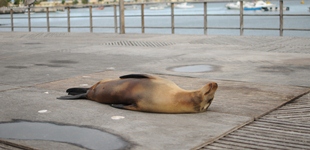 Walking
in the Galapagos, you cannot but be overwhelmed by the number of seals lazing around. In roads, on beaches, on steps, on boats, in fact anywhere where there was a flat or comfortable piece of ground that they could fit on. Except
that we were abruptly corrected by every local. These are not seals – they are sea lions. Sea lions are ‘lobos de mar’ in Spanish, whereas the Spanish for seal is ‘foca’. But ‘lazy lobos de mar’ doesn’t have the same ring.
Walking
in the Galapagos, you cannot but be overwhelmed by the number of seals lazing around. In roads, on beaches, on steps, on boats, in fact anywhere where there was a flat or comfortable piece of ground that they could fit on. Except
that we were abruptly corrected by every local. These are not seals – they are sea lions. Sea lions are ‘lobos de mar’ in Spanish, whereas the Spanish for seal is ‘foca’. But ‘lazy lobos de mar’ doesn’t have the same ring.
Just some photos of our lazy friends.
Leave a Reply
swims-with-sea-lions
Swims With Sea Lions
The highlight of our stay in the Galapagos was without doubt the day trip out and snorkelling at Leon Dormido off the coast of San Cristobal island. Our charismatic guide, cold-turkey photographer Victor, somehow managed to be both excited and nonchalant at the same time, while sharing his knowledge and enthusiasm for the sea and photography with us. He also declared his love for women. The women on board seemed neither threatened nor interested by this.
As we had all taken our sea-sickness pills, there were no repeat performances of the vomiting that had occurred on our boat ride to San Cristobal the previous day. We went first to a closer cove, where Alvaro joined us for his first snorkelling experience. There is little more beautiful than to be sharing with your children their first experiences of some of nature’s wonders. As Paola had held Omar’s hand in Cuba for his first snorkel, so Alvaro and I held hands as he first started to roam around the sea in his snorkelling gear and watch the abundant sea life. Paola was with him and Omar as they had their first experience of a playful sea lion darting at and around them.
But then the piece de resistance. The boat took us out and away from San Cristobal to the outcrops of rock known as Leon Dormido. Sitting atop and in front of the yacht while it was pelting across seas bluer and clearer than any artificial pool or spa could ever equal is a wonderfully free feeling that I struggle to match in my memory. We approached the rocks at speed, and a sudden deceleration signalled that we should start looking for the large turtles after which the islands were named.
As the boat circled the rocks, Victor called out he names of birds as they appeared on ledges or overhead, while his second in command pointed into the water for turtles and sea lions. But that paled into noise when compared with putting on our snorkelling gear and stepping out into the sea.
It was cold. Unsurprisingly, swimming and the adrenalin of what we were seeing put an end to that. We swam around the rock to get used to the sea there, and submerged many times to join the large turtles below, albeit for seconds. But then Victor announced that we would swim between the rocks, where we would be most likely to see the sharks. Which we predictably did. A long way below us, but we all saw them, and knew that they could get to the top and pluck us out faster than any of us would be able to decide which God to shout to for help. What a beautifully chilling experience. Coming out again after lunch, I had Eagle Rays within touching distance below me in the water, and what I suspect where hammerhead sharks in the murky distance below.
I felt really proud of my eldest boys, who at the ages of 7 and 9 had experienced this dive and dared to swim in places where few of their peers would have had the chance. And after years of seemingly exclusive focus on work and children, it felt fantastic to be sharing something like this with Paola. This trip is full of unanticipated bonuses.
Leave a Reply
otra-forma-de-vivir-face-to-face-with-the-aldea-yanapay-school-in-cusco
“Otra Forma de Vivir” – Aldea Yanapay
Walking back to my hostel in Cusco alone a couple of nights ago, I saw a schoolgirl of around 11 or 12 years, still in her school uniform, pushing and cajoling her blind drunk father to get him home. He was teetering all over the road and pavement, and fell twice in the time that I was watching. The saddest part of this horrendous spectacle was that her pleas for ‘papa’ to move along and come home were not desparate. They were routine. Her voice told you that this was a regular chore of getting her pathetically drunk father home. Well dressed, he was no street hobo, and looked very much like an office worker. There was no drama in her voice, just functional resignation. That made it sadder.
Paola was running art workshops in the Aldea Yanapay school for kids aged around 9 to 11. In what seemed like a very sensible idea to get them engaged, she suggested they draw pictures of their families. After abnormal resistance from all of them, one child started. He drew his two brothers, each with a black eye. He refused point blank to draw his parents. His picture of himself was very hurriedly drawn without any care or attention. Paola changed the exercise.
In another class, as I was helping a boy with his maths homework, it became clear he wasn’t going to finish it in time, and I suggested that he finish it at home. As a panic set in, he welled up, and a little girl came wanting to finish his work for him. Trying to calm him down, I could just about make out that he was afraid that his father would beat him for not having finished his homework before getting home.
Machismo and drunkenness are rife in beautiful Cusco. Domestic violence is commonplace in peaceful Cusco. The highest rates of children’s alcoholism in Peru are in the cultural centre that is Cusco. 35% of children are involved in under age labour and exploitation in touristic Cusco. This was the backdrop to the after-school school that Yuri founded back in 2004. An endemic and self-perpetuating cycle of abuse, alcoholism and violence so engrained that it could be traced right back to pre-Hispanic Inca culture and many influences since.
The Aldea Yanapay project doesn’t aim to preach change. It doesn’t mandate this or that moral code. It is there to serve as an example that there is a different way. Hence its descriptor, ‘Otra Forma de vivir’, or another way to live. The founder and head of the project, Yuri, says that he cannot and will not describe the “perfect father”. “However”, he adds “I am sure that it is not a dad who abandons or beats his kids”. The philosophy of love with discipline at the school is there to demonstrate by example to the children that there is a way to live that doesn’t involve beating or abuse. And that underpins his near maniacal diktat with the volunteers that there is to be no shouting, no hitting, and only discipline with love.
Yuri was brutally and beautifully honest with us all in our induction meeting. This was a very refreshing change to the overly volunteer-centric approach of many social projects here, and aligned with my belief that volunteering is not a favour, but a responsibility.
“You are not my clients,” he said. “You are all here for your own reasons, which may be to earn extra credit for your university, to be at peace with yourself, because it’s a cheap way to be in Peru, to do good, or many other reasons. That’s great. But it is important that you remember this project is not about you. It is about these children and what they are going through. They come first, not you”.
His approach is simple. If we cannot serve as examples, then our involvement is not welcome. The children see us as ‘tall people’, like their parents. But we are tall people that say please and thank you. When they look at us tall people and are petrified because they’ve broken something and are expecting a beating, we tell them it’s OK. They will forget us as individuals, but this continuity of behaviour from all involved in the project will leave a mark.
This may sound like a utopian ideal, and somewhat unrealistic and unrepresentative of life. It may also smell of political correctness gone mad. But the backlash we are having in the UK and probably other places about whether a smack is a necessary or destructive act are set against a different context. When the prevalent behaviour is violent and abusive, maybe it makes sense to immerse the children in an equally strong and opposing behaviour set to help them understand the choices that they can make.
Our involvement as volunteers was fleeting, and in a future blog post I will describe what we did. But many volunteers are here for six or more months. And the school itself take a longer term view. A parallel project has started, the cultural centre, which sees youths out of this school turning their attention to pursuits such as photography or computing, and all within the same ethos of love. This gives the programme sustainability beyond any of our brief involvements in a child’s life.
Yuri took our 4 year old daughter around the block on his scooter this evening after she spent the best part of an hour crying that she wanted to go on it. As she was getting on, a group of kids, probably late teens, came past out of college, and all with hugs and respect punches for him. They were alumni of Aldea Yanapay. In the hostel he runs to part fund the project, another alumni has a job looking after the guests. If it’s made a difference to these handful of people that I saw in this one night, surely that’s already worthwhile?
Things you can do to help if so inclined.
1) Volunteer. The Aldea Yanapay is always looking for responsible volunteers.
2) If you are visiting Cusco, eat at the Aldea Yanapay restaurant or stay at the Hostal Magico. Both of these help fund the school.
3) Donate.
Funds and supplies are always needed for the school. We have seen from working there how sparse books and toys are at the very least.
2 Responses to “Otra Forma de Vivir” – Aldea Yanapay
Leave a Reply
cusco-and-the-hostal-magico
Cusco’s Magic Hostel
 Sitting in the hostel
at night after a collective grilled chicken and chips run, and the guys here including my son Omar and the founder of the Aldea Yanapay school, Yuri, are playing a game with a set of round cards that I’ve not seen before. The intensity
has closed their heads into a circle so tight that a slight involuntary lurch forward from any one of them could give all seven concussion. My 4 year old daughter has her head lodged between the waists of Omar and Yuri, and is
throwing everyone off with occasional random yelps of nonsense.
Sitting in the hostel
at night after a collective grilled chicken and chips run, and the guys here including my son Omar and the founder of the Aldea Yanapay school, Yuri, are playing a game with a set of round cards that I’ve not seen before. The intensity
has closed their heads into a circle so tight that a slight involuntary lurch forward from any one of them could give all seven concussion. My 4 year old daughter has her head lodged between the waists of Omar and Yuri, and is
throwing everyone off with occasional random yelps of nonsense.
This is the community. Everyone has washed their dishes in the outside sink. Perrine has been passing her amazing Belgian chocolates round. The French ladies are so late with their beer run to the shops that a sangria, improvised by the Spaniards, has been drunk dry against all expectations. Spaniards, Columbians, French, Americans, Brits, Belgians, Germans, Swedes and Kiwis (not to mention this Palestinian) share this space. It has a distinctly communal feel about it, without the drugs. Not that opportunities on that count are lacking in Cusco, as I’ve been approached about once every couple of days by a dealer. But that doesn’t seem to have made its way into the hostel.
Every morning Paola goes out for a few hours to train for the Machu Picchu trail that she will be walking in a week’s time, and I get ‘quality time’ with the children. Which comprises mainly of a game of shower whack-a-mole, as the water from the showers is unpredictable both in quantity and temperature, randomly alternating between water, no water, hot water only, cold water only, and for moments just long enough to tease you into staying, the right amount of water with full control over the temperature. And into all of that I try to shuffle four children with barely enough towels, and a walk through the courtyard to and from the bedroom. This in itself is no small feat as many of the doors are at head-bruising height. At the end, I get to play shower Russian Roulette myself, knowing I will be either scalded or cold but definitely clean. Almost.
Breakfast for the children is from a very basic kitchen. I usually need to pop out to the grocer next door to replenish cereal supplies for their insatiable appetites. There is no feeling of risk doing this for a few minutes with the children roaming the hostel. Most of the residents are volunteers, many have made friends with our children, and a couple of them nearly had our youngest two leaving with them of their own volition. For sure, there are more physically comfortable places to stay, but the caring, the security and the fun mean that we will stay in the Hostal Magico a couple more weeks in preference to moving somewhere more luxurious.
The rest of the morning is spent with the children either doing some work or reading waiting for Paola to come back before we all to go out to lunch. We head to school for the day’s volunteering, leaving just enough time to go into town, feed the family, get back to the hostel, and beat a disorderly retreat to bed for the six of us. Simple days, but rewarding.
More rewarding, however, are the people we met while here.
[album: https://oursouthamericablog.com/wp-content/plugins/dm-albums/dm-albums.php?currdir=/wp-content/uploads/dm-albums/Hostal Magico/]Late August saw Alvaro’s eighth birthday. Bereft of his friends back in England and Spain, the residents on the hostel gamely stepped in to make his birthday special. I’m sure that the cake we bought had little to do with it, but in the evening we had multi-lingual renditions of Happy Birthday in the central courtyard. I know he loved this birthday.
But extra special was yet to come. A lady with one of the biggest hearts I’ve met, in fact so big I could scarcely see how it fit inside her slim frame, gave Alvaro a small leather pouch of Cusco and Machu Picchu. But inside, Marina had written him a little note entitled “to Alvaro on his ways out in life”.
“Alvaro. Each person has something special inside them. No one is better than anyone else, we’re just good at different things. Sometimes when you doubt yourself, remember that and believe in yourself, and that you can do it. Because you can! I know that because I met you 🙂 and you are a very special guy! Never ever forget that! All my (heart) and luck to you. Marina.”
Marina, just for taking the time and thought to do that, you will sit in our hearts. All your other continuing kindness that we saw to us, to the people that you help in your various endeavours, to the children in Aldea Yanapay marked this out as not atypical from you. Thank you, and I hope our paths cross again.
She was not alone. As you would expect in a community of volunteers, most had a worldview that extended beyond their pockets, and were giving their most abundant gift, caring, alongside the one that they could never replenish, time. Amie, the photographer who wants to make a difference with her photos; Perrine, never failing over months of solid dedication to the kids there; Justin, who at the tender age of 18 had already given months to Cusco’s children. So many more whom I am committing the injustice of not listing for fear of making this blog post a list of all the volunteers. And that’s not to mention the fantastic staff, Flor, Sonya, Roxanne (the “mother” of the hostel), Claudia, and all the others ready to step in and help with our children at a minute’s notice.
We are not unhappy with our choice of hostel.
4 Responses to Cusco’s Magic Hostel
-
Love reading all about your adventures, this time and experience you are all having sounds wonderful, what your kids will have from this, they will never learn from a book. To have such quality time and memories, enjoy and be safe.
Siobhan and her boys. -
So , one day they all stormed in and filled our hostel with life :). We we re all amazed by the experience in itself and that this family managed to travel just like we did but with 4 children . It was truly inspiring and wonderful to meet all of you . To see how your children helped each other and to watch them volunteer . They may not know just yet , but they are going to grow up with views broader than the most and I m sure that they are going to be filled with courage and independence. What greater gift can you possibly give your children than that and the oppurtunity to share from their hearts . All my luck and best wishes to you on your journey ! And yes we missed you guys 🙂 ! / Marina
-
And we all loved you Marina far more than 3 weeks would warrant! Hope you are staying well!


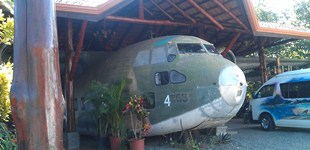
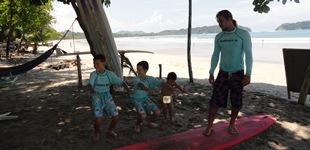
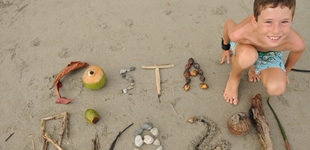
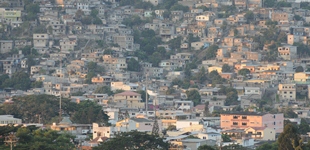
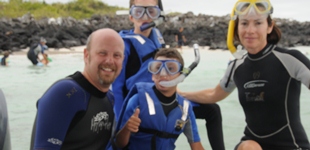
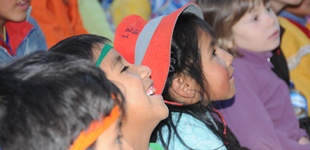
Hola beautiful family!
Oooohhhhh, we are missing you already!
It has been such a pleasure to meet with you in Cusco and can’t wait to reconnect again in Argentina (hopefully!) to share more pizza and great laughters!
Hope you are enjoying lovely Arequipa.
Yudé+lola loved to visit Alvaro and Omar’s blogs this morning, will be a great opportunity for Yudé to practice his english reading! What a great example of travel schooling!
Besos to all six of you from us four xxxx
Love and light in your travels 🙂
Marie-Pierre, Patrice, Yudé+Lola
http://www.yudeandlola.com
Hey – we are in Argentina. Are you coming? We have pizza on order….